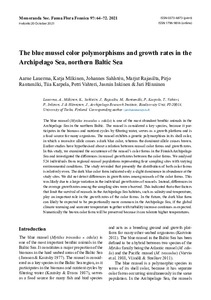The blue mussel color polymorphisms and growth rates in the Archipelago Sea, northern Baltic Sea
Karpela Tiia; Sahlstén Johannes; Lauerma Aarne; Hänninen Jari; Rajasilta Marjut; Rantamäki Pirjo; Vahteri Petri; Inkinen Jasmin; Mäkinen Katja
https://urn.fi/URN:NBN:fi-fe2021102752667
Tiivistelmä
The blue mussel (Mytilus trossulus × edulis) is one of the most abundant benthic animals in the Archipelago Sea in the northern Baltic. The mussel is considered a key species, because it participates in the biomass and nutrient cycles by filtering water, serves as a growth platform and is a food source for many organisms. The mussel exhibits a genetic polymorphism in its shell color, in which a recessive allele causes a dark blue color, whereas the dominant allele causes brown. Earlier studies have hypothesised about a relation between mussel color forms and growth rates. In this study, we examined the occurrence of the mussel’s color forms in the Finnish Archipelago Sea and investigated the differences in mussel growth rates between the color forms. We analysed 524 individuals from regional mussel populations representing four sampling sites with varying environmental conditions. The study revealed that presently the distribution of both color forms is relatively even. The dark blue color form indicated only a slight dominance in abundance at the study sites. We did not detect differences in growth rates among mussels of the color forms. This was likely due to a large variation in the individual growth rates of mussels. Instead, differences in the average growth rates among the sampling sites were observed. This indicated that other factors that limit the survival of mussels in the Archipelago Sea habitats, such as salinity and temperature, play an important role in the growth rates of the color forms. In the future, the dark blue form can likely be expected to be proportionally more common in the Archipelago Sea, if the global climate warming and seawater temperature together with turbidity increase continues as expected. Numerically the brown color form will be preserved because it can tolerate higher temperatures.
Kokoelmat
- Rinnakkaistallenteet [19207]
